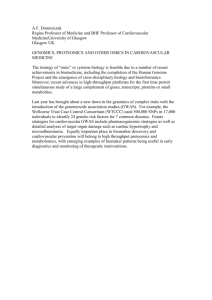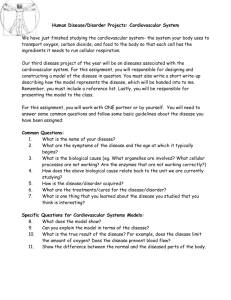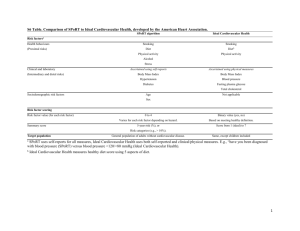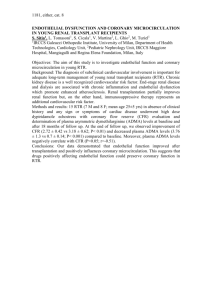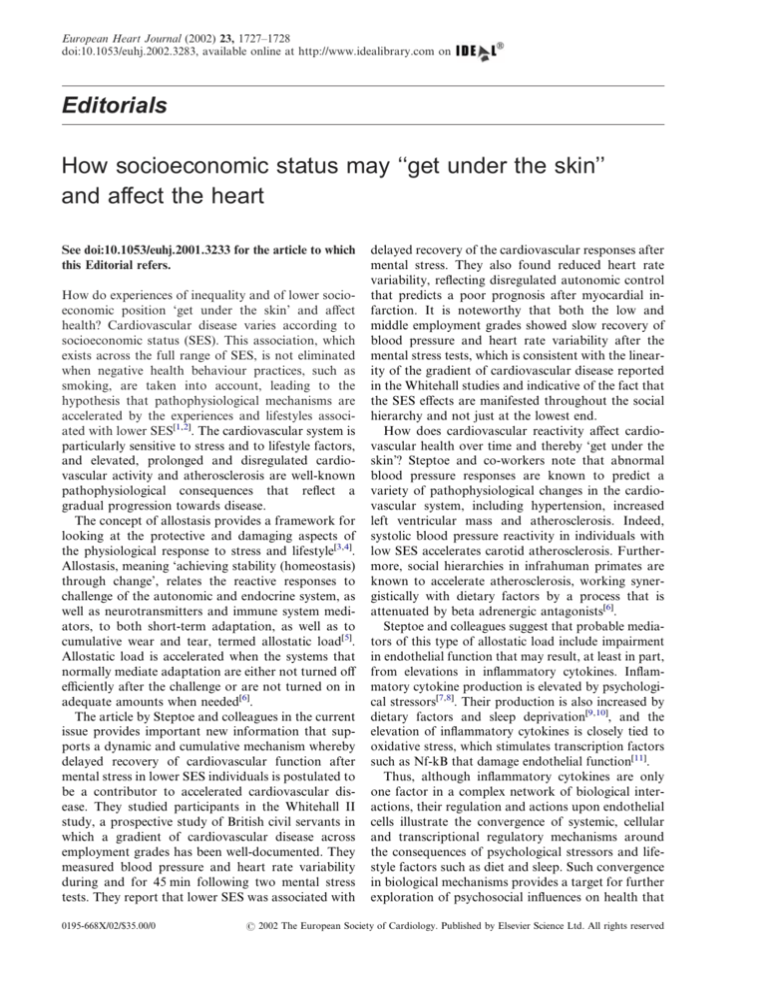
European Heart Journal (2002) 23, 1727–1728
doi:10.1053/euhj.2002.3283, available online at http://www.idealibrary.com on
Editorials
How socioeconomic status may ‘‘get under the skin’’
and affect the heart
See doi:10.1053/euhj.2001.3233 for the article to which
this Editorial refers.
How do experiences of inequality and of lower socioeconomic position ‘get under the skin’ and affect
health? Cardiovascular disease varies according to
socioeconomic status (SES). This association, which
exists across the full range of SES, is not eliminated
when negative health behaviour practices, such as
smoking, are taken into account, leading to the
hypothesis that pathophysiological mechanisms are
accelerated by the experiences and lifestyles associated with lower SES[1,2]. The cardiovascular system is
particularly sensitive to stress and to lifestyle factors,
and elevated, prolonged and disregulated cardiovascular activity and atherosclerosis are well-known
pathophysiological consequences that reflect a
gradual progression towards disease.
The concept of allostasis provides a framework for
looking at the protective and damaging aspects of
the physiological response to stress and lifestyle[3,4].
Allostasis, meaning ‘achieving stability (homeostasis)
through change’, relates the reactive responses to
challenge of the autonomic and endocrine system, as
well as neurotransmitters and immune system mediators, to both short-term adaptation, as well as to
cumulative wear and tear, termed allostatic load[5].
Allostatic load is accelerated when the systems that
normally mediate adaptation are either not turned off
efficiently after the challenge or are not turned on in
adequate amounts when needed[6].
The article by Steptoe and colleagues in the current
issue provides important new information that supports a dynamic and cumulative mechanism whereby
delayed recovery of cardiovascular function after
mental stress in lower SES individuals is postulated to
be a contributor to accelerated cardiovascular disease. They studied participants in the Whitehall II
study, a prospective study of British civil servants in
which a gradient of cardiovascular disease across
employment grades has been well-documented. They
measured blood pressure and heart rate variability
during and for 45 min following two mental stress
tests. They report that lower SES was associated with
0195-668X/02/$35.00/0
delayed recovery of the cardiovascular responses after
mental stress. They also found reduced heart rate
variability, reflecting disregulated autonomic control
that predicts a poor prognosis after myocardial infarction. It is noteworthy that both the low and
middle employment grades showed slow recovery of
blood pressure and heart rate variability after the
mental stress tests, which is consistent with the linearity of the gradient of cardiovascular disease reported
in the Whitehall studies and indicative of the fact that
the SES effects are manifested throughout the social
hierarchy and not just at the lowest end.
How does cardiovascular reactivity affect cardiovascular health over time and thereby ‘get under the
skin’? Steptoe and co-workers note that abnormal
blood pressure responses are known to predict a
variety of pathophysiological changes in the cardiovascular system, including hypertension, increased
left ventricular mass and atherosclerosis. Indeed,
systolic blood pressure reactivity in individuals with
low SES accelerates carotid atherosclerosis. Furthermore, social hierarchies in infrahuman primates are
known to accelerate atherosclerosis, working synergistically with dietary factors by a process that is
attenuated by beta adrenergic antagonists[6].
Steptoe and colleagues suggest that probable mediators of this type of allostatic load include impairment
in endothelial function that may result, at least in part,
from elevations in inflammatory cytokines. Inflammatory cytokine production is elevated by psychological stressors[7,8]. Their production is also increased by
dietary factors and sleep deprivation[9,10], and the
elevation of inflammatory cytokines is closely tied to
oxidative stress, which stimulates transcription factors
such as Nf-kB that damage endothelial function[11].
Thus, although inflammatory cytokines are only
one factor in a complex network of biological interactions, their regulation and actions upon endothelial
cells illustrate the convergence of systemic, cellular
and transcriptional regulatory mechanisms around
the consequences of psychological stressors and lifestyle factors such as diet and sleep. Such convergence
in biological mechanisms provides a target for further
exploration of psychosocial influences on health that
2002 The European Society of Cardiology. Published by Elsevier Science Ltd. All rights reserved
1728
Editorials
may well be able to elucidate how the effects of SES
on cardiovascular reactivity and recovery seen by
Steptoe and colleagues ultimately exert their influence
on cardiovascular health.
B. S. MCEWEN
A. E. MIRSKY
Harold and Margaret Milliken Hatch Laboratory of
Neuroendocrinology,
The Rockefeller University,
New York, NY, U.S.A.
[4]
[5]
[6]
[7]
[8]
References
[9]
[1] Adler NE, Boyce T, Chesney MA et al. Socioeconomic status
and health: the challenge of the gradient. Am Psychol 1994;
49: 15–24.
[2] Adler NE, Marmot M, McEwen BS, Stewart JE. Socioeconomic Status and Health in Industrial Nations: Social,
psychological, and biological pathways, Vol. 896. New York:
The New York Academy of Sciences, 1999.
[3] Sterling P, Eyer J. Allostasis: A New Paradigm to Explain
Arousal Pathology. In: Fisher S, Reason J, eds. Handbook of
[10]
[11]
Life Stress, Cognition and Health. New York: John Wiley &
Sons, 1988: 629–49.
McEwen BS, Stellar E. Stress and the individual: mechanisms
leading to disease. Arch Int Med 1993; 153: 2093–101.
McEwen BS. Protective and damaging effects of stress mediators. N Engl J Med 1998; 338: 171–9.
Manuck SB, Kaplan JR, Muldoon MF, Adams MR,
Clarkson TB. The behavioral exacerbation of atherosclerosis and its inhibition by propranolol. In: McCabe PM,
Schneiderman N, Field TM, Skyler JS, eds. Stress, Coping
and Disease. Hove and London: Lawrence Erlbaum
Associates, 1991: 51–72.
Altemus M, Rao B, Dhabhar FS, Ding W, Granstein RD.
Stress-induced changes in skin barrier function in healthy
women. J Invest Dermatol 2001; 117: 309–17.
Steptoe A, Willemsen G, Owen N, Flower L, Mohamed-Ali V.
Acute mental stress elicits delayed increases in circulating
inflammatory cytokine levels. Clin Sci 2001; 101: 185–92.
Obal F Jr, Krueger JM. Hormones, cytokines, and sleep.
In: Coping with the Environment: Neural and Endocrine
Mechanisms, Vol. IV. New York: Oxford University Press,
2000: 331–49.
Bierhaus A, Schiekofer S, Schwaninger M et al. Diabetesassociated sustained activation of the transcription factor
nuclear factor-B. Diabetes 2001; 50: 2792–808.
Barnes PJ, Karin M. Nuclear factor-B — a pivotal transcription factor in chronic inflammatory diseases. N Engl J Med
1997; 336: 1066–71.
European Heart Journal (2002) 23, 1728–1730
doi:10.1053/euhj.2002.3310, available online at http://www.idealibrary.com on
Is measuring endothelial function a good idea for
prediction of coronary heart disease complications?
See doi:10.1053/euhj.2001.3237 for the article to which
this Editorial refers
Endothelial cells play an essential role in almost all
basic biological functions, in health and disease. The
endothelial cell presents a selectively permeable
barrier and has the ability to respond to haemodynamic shear forces; it mediates vasorelaxation and
vasocontraction; it is antithrombogenic by maintaining a nonadhesive surface for leukocytes, has anticoagulant (glycosaminglycans, thrombomodulin),
and fibrinolytic properties (tissue plasminogen
activator); but also produces the most important
antagonist of the fibrinolytic system, plasminogenactivator-inhibitor 1, and other coagulation factors
(tissue factor; von Willebrand factor) upon activation; it mediates cell growth and proliferation and
angiogenesis; it is involved in inflammatory (and
antiinflammatory activities via nitric oxide) and
immune mechanisms in the vessel wall, and plays a
role in extracellular matrix reorganization[1].
Activated endothelial cells express various cellular
adhesion molecules (CAMs; VCAM-1, ICAM-1,
E-selectin), cytokines (interleukin (IL)-1; tumour
necrosis factor-), and chemokines (monocyte
chemoattractant factor 1, IL-8)[2]. Selectins from
activated endothelial cells mediate leukocyte ‘rolling’
that leads to low-affinity interaction with endothelial
CAMs. Firm adhesion and extravasation of leukocytes is mediated by chemokine-induced activated
leukocyte integrin interaction[3].
Thus, endothelial dysfunction implies an imbalance
between relaxation and contraction, between antiand prothrombogenicity, and between antiproliferation and proliferation, favouring the latter. Several
studies have shown that it is closely correlated
with the number of cardiovascular risk factors[4] and
according to our current understanding[2], dysfunction of activated endothelial cells represents the initial
step in atherogenesis.
Direct assessment of endothelial dysfunction by
invasive procedures has been shown to be a strong
2002 The European Society of Cardiology. Published by Elsevier Science Ltd. All rights reserved.



